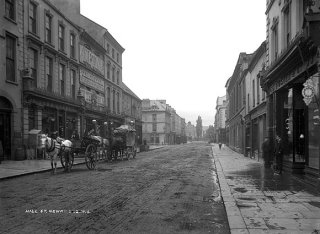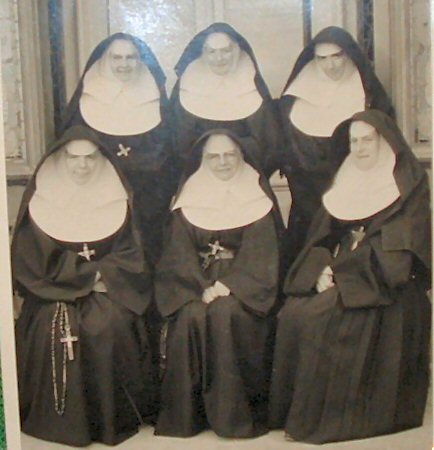Many of you attended John McCavitt’s ‘Flight of the Earls’ CD launch in the Arts Centre’s auditorium last evening for there was a packed house and indeed, extra temporary seating had to be installed. You were well entertained and informed and many availed of the opportunity to purchase the historical/musical CD. It will shortly be available in the shops but meanwhile it can be purchased from John through his great website (http://www.theflightoftheearls.net/) where too the following article (reproduced here by permission) can be browsed.
History
Hills Street?
Why
Emmanuel Chapel
Charles Russell, Lord Chief Justice of
Elizabeth’s Role
Mother Aquin suffered her first bout of illness in 1864 and really never fully recovered. When well enough, she taught in the school and periods of remission were filled with good and useful works.
Lurgan Mercy House
Sarah was the youngest Russell girl. She became Sister Emmanuel. In 1866 she was sent as
Cannibalism in Newry
In the aftermath of Kinsale (1601) – in which battle over 1200 Irish were slaughtered and decapitated even in flight – Sir Arthur Chichester advocated a ruthless policy across the country of spoilation, terror and destruction that before long became the policy of Mountjoy’s forces. In places where
Newry & Rostrevor Convents
At the invitation of Bishop Blake, a group of Mercy Sisters set out from Kinsale on 26 June 1855, with the object of establishing a Convent in Newry. They were led by Sr. Catherine O’Connor and included Newry girl and novice Elizabeth Russell.
Abbey of Viride Lignum
The Cistercian Monastery at Newry was established before the arrival of conquering
Ross Monument
The obelisk on the edge of Rostrevor is dedicated to the memory of one Major-General Robert Ross who distinguished himself in battles for the English on the continents of Europe and America.
Ross Monument History
Ross was born hereabouts in 1766. His first victory as a commander was in 1799 at Helder. Thereafter he fought in the protracted campaigns against Napoleonic France. These battles included Alexandria 1804, Heida 1806, Corunna 1809, Victoria, Orthes and the Pyrennes, 1813. He campaigned the following year at Bladensburg and later in the same year fell at Baltimore, America where the English were nevertheless victorious.
He is remembered for having set fire to the White House. But the English campaign in America is not remembered fondly by either side. In that final year most of the Library of Congress also was destroyed by fire set by English troops. In September a U.S. naval force defeated and captured a British squadron on Lake Champlain in the Battle of Plattsburgh. The planned British invasion of America from Canada had to be abandoned.
In the early days of the New Year, the British were finally defeated at the Battle of New Orleans, where they lost 700 men.
In Ross’ town of birth Rostrevor, County Down in Northern Ireland, he is celebrated by a 99-foot granite obelisk near the coastline of Carlingford Lough. The Monument, a 100-foot granite obelisk, was brought back in 2008. [15] A smaller sized monolith was erected in Kilbroney Parish Church by soldiers who had actually served with Ross at the Battle of Maida in 1806. [16] This granite memorial was erected in 1826 “on a hill within view of his sad widow’s house”, according to a 2013 report.
Ross is likewise honored by a National Monument in St Paul’s Cathedral in London, England. The latter is explained by a book about Ross as: “Britannia is represented weeping over the burial place of the left warrior, over which an, American flag is being transferred by a figure of Valour, while Fame comes down with a wreath of laurels to crown the hero’s head”.
The engraving on the National Monument checks out:
DEDICATED AT THE PUBLIC EXPENSE TO THE MEMORY
OF MAJOR GENERAL ROBERT ROSS
WHO HAVING UNDERTOOK AND EXECUTED AN ENTERPRISE AGAINST THE
CITY OF WASHINGTON, THE CAPITAL OF THE UNITED STATES OF AMERICA
WHICH WAS CROWNED WITH COMPLETE SUCCESS WAS KILLED SHORTLY
AFTERWARDS WHILE DIRECTING A SUCCESSFUL ATTACK UPON A SUPERIOR FORCE NEAR THE
CITY OF BALTIMORE ON THE 12TH DAY OF SEPTEMPTER 1814
By the start of the Troubles in the 1960s, the monolith in Rostrevor – now situated in a mainly Roman Catholic area – was mainly disregarded and overgrown by brambles; this might have added to its preventing the very same fate as Nelson’s Pillar in Dublin, which was apparently exploded by the IRA in 1966. After the Good Friday Agreement in 1998, the Newry and Mourne District Council, though mainly Irish republican politician, accepted recondition the monolith as part of Rostrevor’s history, and it was resumed in 2008.
Neither General Ross nor his instant descendants were knighted or gotten a title of nobility. His descendants were offered an enhancement of honour to the Ross armorial bearings (particularly, the addition of a chief to the guard and a 2nd crest, both portraying an arm understanding the 15 stars and 15 stripes on a damaged personnel, along with the extra slogan of “Bladensburg”) and the household name was altered to the triumph title “Ross-of-Bladensburg”, which was approved to his widow.
In honour of the history of Washington, D.C., there is likewise a picture of Ross in the U. S. Capitol’s rotunda and a number of illustrations in different War of 1812 archaeological sites in the Baltimore location, consisting of a Monument near the website off Old North Point Road where he allegedly was shot. Extra information and exhibitions have actually been protected in different Baltimore historic organizations, such as the Star Spangled Banner Flag House (likewise understood just recently as the Flag House and Star-Spangled Banner Museum) and the National Park Service website of Fort McHenry’s visitor center displays and in the regional Dundalk-Patapsco Neck Historical Society museum in Dundalk, Maryland.
According to a history of the Major-General by Robert Lacy, Ross was a soldier who integrated care with guts. Due to the fact that of his desire to share their difficulties and to combat along with them in the thick of fight, he was exceptionally popular with his males. An associate stated of him that he might not be ‘a much better male nor a more zealous officer’. Due to the fact that of his never-failing courtesy and heroic conduct, Ross likewise commanded the regard and adoration of his challengers. Among the leading doctors in Washington commemorated Ross’s ‘practiced modesty and politeness’.
Regional tradition shows that the two snipers/riflemen “Wells and McComas” (of the system of Aisquith’s Sharpshooters”) were buried in a regional churchyard grieved by their fellow soldiers and people of the Town, however later on in the 1850s were exhumed and reburied after fancy processions and funeral services in a significant burial place in Ashland Square, off of Orleans Street and North Gay Street in the Jonestown/Old Town community of East Baltimore. City streets were likewise called for them in South Baltimore.








